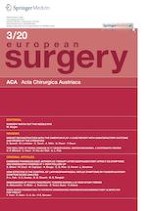08.04.2020 | original article
Combined pharmacologic antireflux therapy after esophagectomy: effect on symptoms and endoscopic findings at 1-year follow-up
Erschienen in: European Surgery | Ausgabe 3/2020
Einloggen, um Zugang zu erhaltenSummary
Objective
Heartburn, regurgitation, pulmonary aspiration, and remnant esophagitis represent common sequelae of esophagectomy and gastric conduit reconstruction. Proton pump inhibitors are the mainstay of treatment. The aim of the study was to focus on the efficacy of combination therapy with mucosal surface protection.
Materials and methods
Patients undergoing esophagectomy were followed up to 1 year. Patients in group A received 60 mg/day lansoprazole and those in group B received combination therapy. During follow-up, the dosage of lansoprazole was reduced to 30 mg/day in asymptomatic patients with or without grade A–B esophagitis. The Gastro-Esophageal Reflux Disease – Health-Related Quality of Life (GERD-HRQL) and the Short-Form 36 (SF-36) were used to assess postoperative quality of life, and the foregut symptom questionnaire to assess the prevalence of regurgitation, respiratory symptoms, and sleep disorders.
Results
Between August 2017 and August 2018, 56 patients were enrolled in the study. Over follow-up, the incidence of refractory symptoms and/or esophagitis grade C–D was 35.7% in group A and 21.4% in group B (p = 0.024). At 1 year, 18 (64.2%) patients in group A and 22 (78.5%) in group B remained symptom free and without severe esophagitis under treatment with 30 mg of lansoprazole (p = 0.076). The GERD-HRQL score was similar at 3 and 6 months (p = 0.790 and p = 0.812, respectively); at 12 months, patients in group B had a lower score although the difference was not significant (p = 0.216). There were no statistically significant differences in terms of SF-36 scores at 1‑year follow-up. Concerning the foregut symptom questionnaire, group B experienced less respiratory symptoms (p = 0.045) and sleep disorders (p = 0.039).
Conclusion
At 1‑year after esophagectomy, combination therapy with 30 mg lansoprazole and Esoxx® appears to be an effective antireflux strategy.
Anzeige
